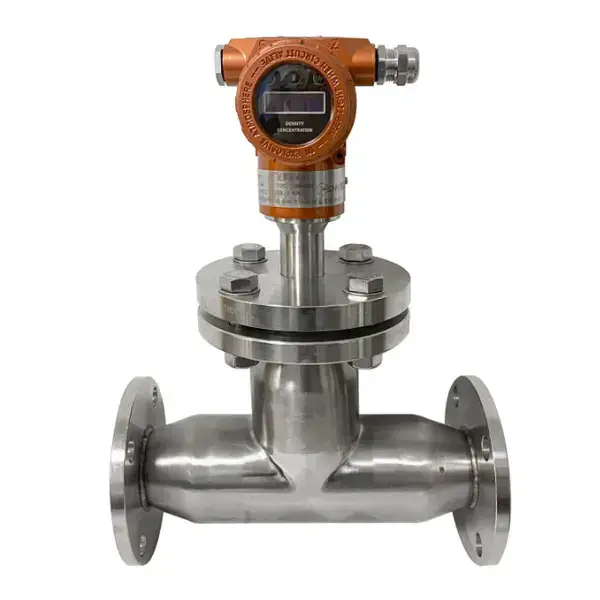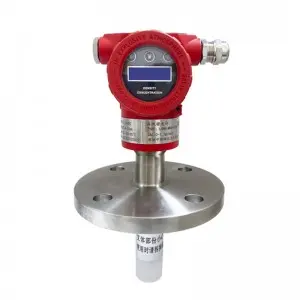Sulfuric acid is a widely used solution in numerous industries like fertilizers, chemicals and even petroleum refining. Real-time density measurement turns important in reaching the target concentration, especially 98%. In the concentration processes of sulfuric acid, evaporation is the efficient method to ensure product quality while guaranteeing certain operational efficiency and equipment safety.
The integration of inline density meters on the inlet and outlet of evaporators provides real-time, accurate concentration measurements, allowing operators to optimize the production process, maintain product quality, and prevent costly inefficiencies.
Challenges in Concentration of Sulfuric Acid
Sulfuric acid production involves complex chemical reactions and demanding environmental conditions. Concentration monitoring during the evaporation stage is particularly challenging due to the following factors:
1. Corrosion on Equipment
High-concentration sulfuric acid is highly corrosive and poses risks to evaporators and pipelines just for its highly corrosive nature. Special corrosion-resistant materials are required to withstand high temperatures, such as borosilicate glass, PTFE, tantalum, and glass-lined steel.
2. Energy Consumption
Evaporation is an energy-intensive process, and inefficiencies can lead to excessive energy use. Without accurate concentration data, operators may overuse energy to reach the target concentration or run the risk of producing suboptimal acid.
3. Quality Control
Inconsistent concentrations can compromise the acid’s suitability for its intended application. Subpar quality may result in product rejection or additional processing costs to meet industrial standards.
4. Process Safety
Improper concentration control increases the risk of hazardous incidents, such as overheating, which can lead to dangerous chemical reactions.


Precise Control Over Sulfuric Acid Concentration
Precise concentration control in sulfuric acid production brings several operational and economic benefits:
- Product Consistency
Sulfuric acid with consistent concentration ensures its effectiveness in downstream applications, meeting customer specifications and regulatory requirements. - Optimized Evaporation Process
Real-time concentration data allows operators to fine-tune the evaporation process, ensuring efficiency and reducing energy costs. - Reduced Maintenance Costs
By preventing over-concentration, inline density meters help mitigate equipment wear and tear caused by corrosive environments. This reduces the frequency and cost of maintenance. - Waste Minimization
Accurate monitoring ensures that raw materials are used efficiently, minimizing waste and improving sustainability. - Safety and Compliance
Controlled concentrations reduce the likelihood of accidents, ensuring safe operations and compliance with environmental regulations.
Advantages of Inline Density Meters in Sulfuric Acid Concentration
Inline density meters are indispensable in modern sulfuric acid production due to their reliability, accuracy, and ability to operate in challenging conditions. Here’s how they add value to the process:
Real-Time Monitoring
Inline density meters provide continuous, real-time data on sulfuric acid concentration. Mounted on the inlet of the evaporator, they measure the initial concentration of the feed solution, helping operators set accurate process parameters. At the outlet, only eligible resolution will be released when its concentration reaches 98%.
Energy Optimization
By monitoring concentration at both stages, density meters enable precise control over evaporation conditions, reducing energy waste and improving operational efficiency.
Non-Nuclear Technology
Modern inline density meters, such as ultrasonic models, are non-nuclear, making them safer and easier to operate. Unlike nuclear density meters, they do not require complex regulatory approvals or pose health risks.
Durability in Harsh Conditions
Inline density meters are designed with corrosion-resistant materials to withstand the harsh environments of sulfuric acid production. This durability ensures consistent performance and long service life.
Automation Integration
These devices can be integrated into automated control systems, allowing operators to adjust process variables, such as temperature and flow rate, based on real-time concentration data. This automation improves accuracy and reduces the likelihood of human error.
Cost Savings
With better process control, inline density meters reduce raw material waste, energy consumption, and maintenance costs, resulting in significant financial savings for manufacturers.
In chemical or fertilizer production, concentration of sulfuric acid through evaporators is one of the critical process to reach certain concentration for specific purposes. Therefore, precision concentration comes to the top priority in concentration. At the same time, all measures should be taken to guarantee safety in production.
Ultrasonic density meter is an ideal option in reaching the designated concentration, offering precision readings to end-users while reduce risks of potential accidents. Manual sampling is taken place by intelligent concentration monitoring, improving efficiency of automation processes and offering assistance for decision-making.
Precision density control by the acid density meter optimize the energy usage and waste, lowering impacts to environments as much as possible. In addition, operation safety could be enhanced too after integrating the acid density meter digital into evaporator systems, which makes real-time adjustment possible in reducing potential risks like overheating or equipment corrosion.
Unmatched accuracy eliminated human errors and manual intervention, making a leap frog breakthroughs in the pursuit of precision and safety in demanding industrial environments. Consult Lonnmeter -- the expert of concentration, density and viscosity measurement with your specific requirements. Get professional suggestions on density, concentration and viscosity measurement in real-time to bridge the gap between harsh conditions and stringent requirements.
Post time: Dec-31-2024





